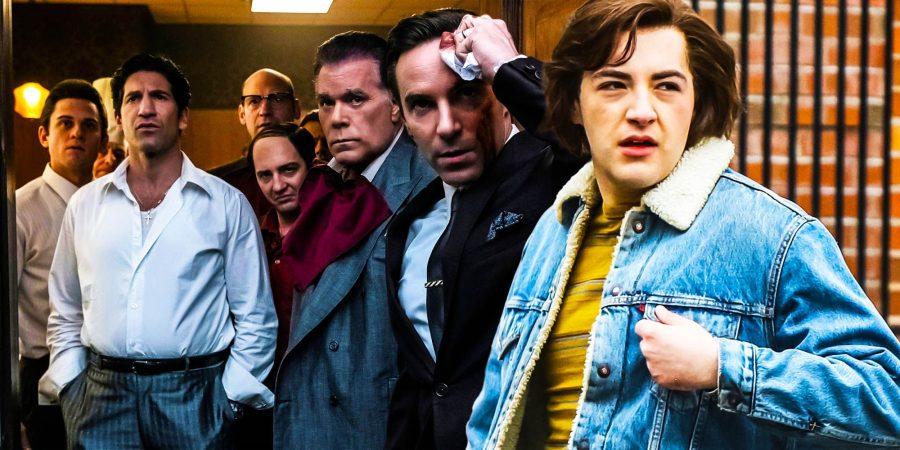Despite a well-rounded cast and updated cinematography, David Chase’s return to the “Sopranos” universe is sunk by muddled subplots and hollow fan service.
I started watching “The Sopranos” in early 2020 after reading many an Internet listicle claiming that it was the greatest television show of the prestige television era — a time when slow-burning, antihero-driven dramas like “Mad Men” and “Breaking Bad” ruled the small screen. Although initially put off by the show’s startling violence, I was soon deeply invested in the story of charismatic mobster Tony Soprano, played perfectly by the late James Gandolfini. I binge-watched the first five seasons while HBO was streaming them for free. Once HBO’s promotion ended, I spent my first paycheck on the final season of the show. After each episode, I poured over Emily VanDerWerff’s razor-sharp reviews of the series at The A.V. Club, where she explored running themes of gray morality and fate as well as minor trivia like Lin-Manuel Miranda appearing in the background of a scene. The series was satisfying from start to finish, and it would seem that Gandolfini’s passing in 2013 negated the possibility of any extension to “The Sopranos” universe. That’s why I was surprised to find out that series creator David Chase would be releasing “The Many Saints of Newark,” a spin-off film focused on an in-name-only Sopranos character, in the fall of this year.
Prequels are often doomed by the success of their source material, leaving fans with impossible expectations and creators with the pressure to execute at a level most artists don’t reach even once. “The Many Saints of Newark” sidesteps this issue by focusing on Dickie Moltisanti and Harold McBrayer, two characters absent from the original series. While Gandolfini’s son Michael plays the younger version of his father’s character, he is absent from or secondary in a large portion of the film. As the addendum to the film’s title implies, this isn’t a Tony Soprano story — it’s a Sopranos story. Keep that in mind and you won’t be too disappointed by the sprawling, but ultimately just okay mob movie Chase delivers.
The high point of the film is the performances. Alessandro Nivola as Dickie carries the film with a wide range of conflicting emotions, as he is often torn between helping and hurting those closest to him. After he bashes his wife-beating father’s head into a steering wheel, he shakily says, “Pop,” like a young boy in disbelief at what he’s done. Later, in what might be a memory or a dream sequence, he coaches a blind youth baseball team and smiles wide at their victory. It’s one of the few moments of happiness for his character, who spends most of the film killing people close to him or watching them get killed. Michael Gandolfini similarly breathes new life into the character his father made famous. Not quite immersed in the mob lifestyle yet, young Tony spends his time running a gambling ring at his elementary school and robbing an ice cream truck. The film also explores young Tony’s relationship with his mother Livia Soprano (Vera Farmiga), who fans remember as being the primary antagonist in the first season of “The Sopranos.” Farmiga steals every scene she’s in with her spot-on performance of the perpetually victimized mob wife. Her interactions with Gandolfini give viewers a window into the relationship Tony and his mother could’ve had, if mental health hadn’t been so stigmatized in the 1960s — and if their lives hadn’t been so brutal to begin with.
Another worthwhile aspect of the film is the conflict between Dickie and Harold McBrayer (Leslie Odom Jr.), a Black member of the DiMeo crime family who’s the target of racist jabs and belittling comments from the rest of the gang. After witnessing the Newark Riots in response to an incident of police brutality, McBrayer is inspired to launch his own gambling operation to rival Dickie’s. Hits are taken on both sides as a brutal gang war unfolds, leading to an intense shootout. “The Sopranos” has been criticized for presenting its few BIPOC characters in a stereotypical and one-dimensional light (see: “Christopher,” the infamously clumsy episode about Columbus Day.) Refreshingly, McBrayer in “The Many Saints of Newark” is one of the most well-developed and complex characters of the film. He has clear motivations and compelling emotional turns that stem from the criminal life he lives, as well as the fierce racial tensions of the late ‘60s and early ‘70s. Perhaps the strength of McBrayer’s character, like Dickie’s, comes from the fact that it does not rely on callbacks to the original series. His entire arc must be introduced and resolved within the film’s two-hour runtime. The same can be said of new character Giuseppina, Dickie’s unofficial-stepmom-turned-side-piece who dreams of opening a beauty parlor and has more of a say for herself than many of Tony’s girlfriends did in the series.
While the conflict between Dickie and McBrayer is fully realized, the main plot is muddled by a series of B-plots that leave the viewer confused about the film’s focus. The film is ‘narrated’ by Christopher Moltisanti, Dickie’s son and Tony’s honorary nephew, but Christopher’s lines are maybe two minutes in total. Music ranging from the Stones to Sinatra is used to transition several scenes, often with a jarring suddenness that doesn’t match the film’s murky, cool-toned visuals. The question of what makes Tony Soprano choose the criminal underworld is toyed with, but not given ample development for a satisfactory answer. Even the Newark Riots, the catalyst for McBrayer to strike out on his own, feel like an aspect of the film that could’ve been further explored. “The Many Saints of Newark” has tensions, stakes, and interesting characters, but I was unsure which conflict or relationship to care about at times. Many of the above threads seemed promising, only to not realize their full potential by the end of the film.
“The Sopranos” would often build up rivalries and gang wars, only to boil the conflict down to an unexpected act of violence triggered more by bruised egos than underworld politics. The friction between characters feels like it could go on forever, or like it could be brushed under the rug, lived with — and then somebody snaps. These were the moments that hooked me while watching “The Sopranos.” The same elements are present in “The Many Saints of Newark,” but altogether they don’t function the same way. Whether because of the limitations of the runtime, the difference in medium between television and film, or the absence of Gandolfini’s unmistakable magnetism, this “Sopranos” story doesn’t do the series justice. If you subscribed to HBO Max to stream this film, I’d advise you to watch “The Sopranos” instead.
Grade: C
Director: Alan Taylor
Starring: Alessandro Nivola, Leslie Odom Jr., Michael Gandolfini, Vera Farmiga, Ray Liotta, Gabriella Piazza
Release Date: Oct. 1, 2021
Rated: R
Image courtesy of ScreenRant.
Film Review: “The Many Saints of Newark”
Oct 10, 2021
3
0
About the Contributor

Bailey Bujnosek, Senior Staff Writer
Bailey is a fourth-year English literature and psychology double-major who watches too much reality tv. She likes listening to Mitski, Ricky Montgomery, & Fiona Apple. Her favorite movie is “Whiplash,” the “Black Swan” of jazz drumming.
More to Discover










A • Nov 1, 2021 at 2:07 pm
If you thought Tony Soprano was a real piece of shit, you will love this movie! If he was your hero or antihero you will not.
I LOVED it!
Joseph R Sicari • Oct 13, 2021 at 12:59 pm
you are spot-on in my opinion to the negative aspects of this film, and much too kind to much of it. The violence was unwatchable, and made worse, being in a film that was soooo boring. All violence, and typical cliche goombah talk. The characters are despicable and when there is no depth to them, there’s no worthwhile reason to watch them. Cliche and boring – this whole film. so surprised that David Chase wrote this. Such a brilliant writer.
Mariana Ghita • Oct 12, 2021 at 2:18 am
I think you mean you “pored” over Emily VanDerWerff’s razor-sharp reviews of the series at The A.V. Club.